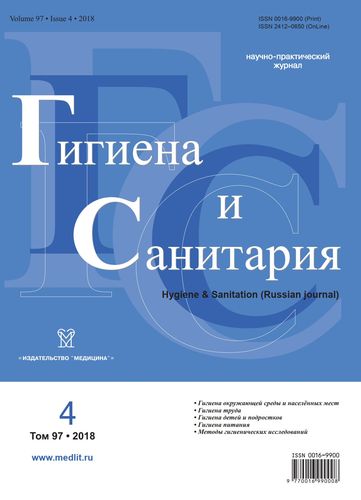About calculation of the deterministic effect of proteinuria in employees of enrichment plants of nuclear industry
- Authors: Babenko S.P.1, Badin A.V.2
-
Affiliations:
- N.E. Bauman Moscow State Technical University
- Department of Physics, M.V. Lomonosov Moscow State University
- Issue: Vol 97, No 4 (2018)
- Pages: 315-321
- Section: OCCUPATIONAL HYGIENE
- Published: 20.10.2020
- URL: https://rjsocmed.com/0016-9900/article/view/640317
- DOI: https://doi.org/10.47470/0016-9900-2018-97-4-315-321
- ID: 640317
Cite item
Full Text
Abstract
In this paper, we consider the impacts of gaseous uranium hexafluoride used at concentrating plants of the nuclear industry on the human body. The appearance of uranium hexafluoride in the air of the working premises is accompanied by hydrolysis and the formation of substances that can enter the human body and bring atoms of uranium and fluorine. The article describes the method of the determination of the working conditions preventing the development of occupational diseases in employees. The method is based both on the calculation of the number of toxic substances entering the human body in routine working conditions and comparison of this number with the threshold values for different deterministic effects. The proteinuria (protein content in urine) is selected as the considered deterministic effect. We used the published statistics on the threshold of the daily release from the human body toxic substances, long-entering the body in small doses and seem to be responsible for the occurrence of urologic diseases. The calculation was performed in the framework of a complex model describing the air pollution with products of hydrolysis of uranium hexafluoride entering of toxic substances in the human body, in working premises, as well as the passing of uranium and fluorine through the body. This model constructed by the authors of this article was described in previous publications. To ensure that the theoretical methods give the same results as the experimental, the results obtained by the standard method for employees of one of the enterprises of nuclear industry were compared with the data obtained using the theoretical method under the same working conditions. The considered theoretical method can complement and enrich the existing experimental methods for the identification of the onset of occupational diseases based on the sampling of different biomaterials from the employees working at enterprises.
About the authors
S. P. Babenko
N.E. Bauman Moscow State Technical University
Author for correspondence.
Email: noemail@neicon.ru
Russian Federation
Andrey V. Badin
Department of Physics, M.V. Lomonosov Moscow State University
Email: badyin@phys.msu.ru
MD, Ph.D., Associate professor of the Department of Mathematics of the Physical Faculty of the M. V. Lomonosov Moscow State University. Moscow, 119991, Russian Federation.
e-mail: badyin@phys.msu.ru
Russian FederationReferences
- Katz J.J., Rabinowitch E. The Chemistry of Uranium. New York, Toronto, London: McGraw-Hill Book Company, Inc.; 1951.
- Nadezhdinskiy A.I., Nabiev Sh.Sh., Grigor’ev G.Yu., Vyazov I.E., Malyugin S.L., Ponomarev Yu.N. et al. Rapid methods for measuring the degree of enrichment of uranium hexafluoride and trace amounts of UF6 and HF in the atmosphere based on diode lasers near and mid-infrared. Optika atmosfery i okeana. 2005; 18(9): 785—794. (in Russian)
- Mirkhaydarov A.Kh. Method and means for measuring uranium hexafluoride in the air. In: The radioactivity in nuclear explosions and accidents. Abstracts of the International Conference. SPb.: Gidrometeoizdat; 2000. (in Russian)
- West C.M., Scott L.M. Uranium cases showing long chest burden retention of uranium. In: USAEC Report HASL-58. 1959; 212—213.
- Gasteva G.N., Bad’in V.I., Molokanov A.A., Mordasheva V.V. Clinical Toxicology of chemical compounds of uranium at chronic exposure. In: Il’in L.A., ed. Nuclear medicine. Volume II. Radiation injury man. M.: IzdAT; 2001; 369—388. (in Russian)
- ICRP, 1994. Human Respiratory Tract Model for Radiological Protection. ICRP Publication 66. Ann. ICRP 24 (1-3).
- ICRP, 2007. The 2007 Recommendations of the International Commission on Radiological Protection. ICRP Publication 103. Ann. ICRP 37 (2—4).
- Babenko S.P., Bad’in A.V., Bad’in V.I. Mathematical modeling of sedimentation UF6 and its hydrolysis products in the presence of gravity. Izvestiya Akademii Promyshlennoy Ekologii. 2003(2): 70—85. (in Russian)
- Babenko S.P., Bad’in A.V. Mathematical model of inhalation of toxic substances in the human body under emergency conditions of nuclear industry. Vestnik Mosk. un-ta. Ser. 3. Fizika. Astronomiya. 2006(1): 36—39. (in Russian)
- Babenko S.P., Bad’in A.V. Inhaler injection and injection through skin of toxic substances in a human organism under regular industry conditions at factories of nuclear industry. Matematicheskoe modelirovanie. 2006; 18(3): 13—22. (in Russian)
- Babenko S.P., Bad’in A.V. Verification of a mathematical model that describes the action of uranium hexafluoride on the human body in facilities of the atomic industry. Moscow University Physics Bulletin. 2014; 69(2): 124—133. https://doi.org/10.3103/S0027134914020040
- Babenko S.P., Bad’in A.V. Determination of the state of aggregation of hydrolysis of uranium hexafluoride products deposited on the skin of a person with the accidental release. Vestnik MGTU im. N.E. Baumana. Ser. «Estestvennye nauki». 2012; 46(3): 115—125. (in Russian)
- Howland J.W. Pharmacology and toxicology of uranium compounds. In: Voegtlin C., Hodge H.C., ed. Studies on human exposures to uranium compounds. New York, Toronto, London: McGraw-Hill Book Company, Inc.; 1949: 993—1017.
- Bogdanov N.A., Gembitskiy E.V. Production fluorosis. L.: Meditsina; 1975. (in Russian)
- Andreeva O.S., Bad’in V.I., Kornilov A.N. The natural and enriched uranium. Radiation-hygienic aspects. M.: Atomizdat; 1979. (in Russian)
- Orcutt J.A. et al. The toxicology of compounds of uranium following application to the skin. In: Pharmacology and toxicology of uranium compounds. Oak Ridge, Tenn.: U.S. Atomic Energy Commission; 1946.
- Galibin G.P. Distribution of uranium in rats when inhaled ammonium diuranate. Gigiena i sanitariya. 1967(12): 40—43. (in Russian)
- Galibin G.P., Novikov Yu.V. Toxicology of industrial uranium compounds. M.: Atomizdat; 1976. (in Russian)
Supplementary files









